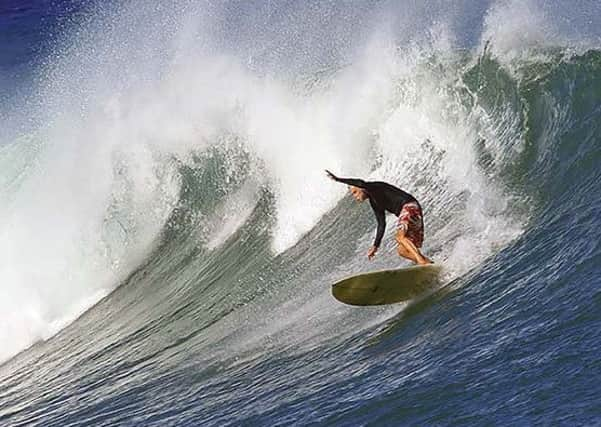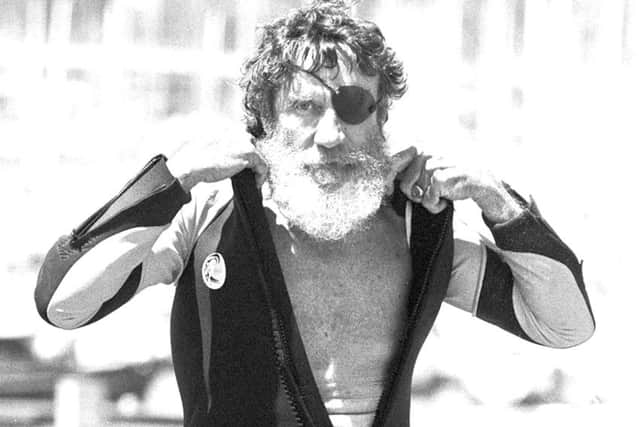The Scottish links of surfing's founding fathers


After catching the surfing bug in his teens and majoring in art education at California State University, Long Beach, Severson set up Surfer in San Clemente in 1962, as a reaction against the way Hollywood was portraying the nascent pastime. Films like Gidget, he felt, were a “cheap, honky look at surfing” and he wanted to present “a truer image of the sport,” one that focused more on the act of waveriding itself and less on beach parties and other peripheral aspects of the surfing lifestyle. Rival surf mags soon sprang up, notably Surfing, which was Surfer’s main competitor from 1964 until it finally closed its doors earlier this year, but Surfer set the template for everything that was to follow.
O’Neill, meanwhile, began experimenting with ways to insulate swimwear in the 1950s, so that he could spend longer surfing in the cool waters off Northern California, and he claimed to have come up with the idea of using neoprene to make wetsuits after seeing the carpet lining on a plane. This claim has subsequently been disputed – a recent LA Times story suggests the real inventor of the neoprene wetsuit was probably a physics professor at UC Berkeley called Hugh Bradner in 1949. But in a sense it doesn’t really matter: whether he was the first person to come up with the idea or not, O’Neill, perhaps more than anybody else, managed to sell the world on the idea that surfing could happen in cold water, thereby opening up virgin surf territory not just in Northern California but all around the globe. He even had his wetsuit-clad kids sit in ice baths at trade shows to demonstrate how well they worked. As his company’s long-running slogan put it, when you’re wearing a wetsuit (preferably an O’Neill one): “it’s always summer on the inside”.
Advertisement
Hide AdAdvertisement
Hide AdBoth Severson and O’Neill can claim to have played a role in the development of surfing in Scotland simply by virtue of what they achieved: the former because, in the pre-internet age, magazines like his were the only way surfers living outside existing surfing hotspots could learn about their sport; the latter because, without wetsuits, nobody would have lasted five minutes surfing in the North Sea or the North Atlantic. But there are other, more specific things linking them to Scotland. In Severson’s case, the connection goes all the way back to 1968, when Surfer magazine ran an article about Scottish surfing based on an interview with Aberdeen’s George Law, who was probably the first person ever to surf here when he took to the waves off Aberdeen in 1967. “Scotland???,” the article began, “Whoever heard of any surf in Scotland? Well, Scotsman George Law reports there’s fine surfing off Aberdeen beach in the chilly North Sea.” It would have been chilly, too: Scottish surf pioneer Andy Bennetts once said of Law that in the early days he used to surf all through the winter wearing nothing but a neoprene vest and a pair of boardshorts. Clearly in the late 1960s the O’Neill marketing department still had some work to do in terms of creating a global market for its products.


But O’Neill did eventually get its message across the Atlantic, as did other wetsuit manufacturers, helping surfing to gradually gain a toe-hold here; and then, in 2006, O’Neill gave Scottish surfing a hefty shove into the global spotlight when it sponsored the first O’Neill Highland Open at Thurso – a World Qualifying Series event that attracted some of the best professional surfers in the world. Much was made of the Highland Open’s status as “the coldest event on the WQS tour” and it subsequently became part of O’Neill’s Cold Water Classics Series – contests showcasing surfing in frigid locations. O’Neill eventually stopped funding the pro event at Thurso in 2012, but by then Scotland’s North Shore was well and truly on the world surfing map, whether it wanted to be or not. n
*For the purposes of this column, “the sport of surfing” refers to surfing’s modern iteration; the true founding fathers of surfing were the ancient Hawaiians, who practised he‘e nalu or “wave sliding” as an integral part of their culture.